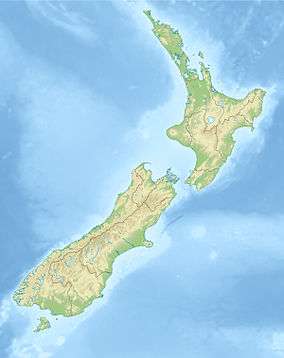Mangere Mountain
| Mangere Mountain | |
|---|---|
 Mangere Mountain seen from Ambury Regional Park | |
| Highest point | |
| Elevation | 106 m (348 ft) |
| Coordinates | 36°56′59″S 174°46′59″E / 36.9496°S 174.7831°ECoordinates: 36°56′59″S 174°46′59″E / 36.9496°S 174.7831°E |
| Geography | |
 Mangere Mountain | |
| Geology | |
| Volcanic arc/belt | Auckland volcanic field |
Mangere Mountain in Mangere Domain is one of the largest volcanic cones in the Auckland volcanic field, with a peak 106 metres above sea level. It was the site of a major pā (Māori fortified settlement) and many of the pā's earthworks are still obvious. It offers spectacular panoramic views of Auckland from its location in the suburb of Mangere.[1][2]
The volcano features two large craters. It has a wide crater with a lava dome near its centre, a feature shared by no other volcano in Auckland. It last erupted approximately 18,000 years ago.[1]
The mountain is one of the largest and best preserved of Auckland's volcanic cones. Many archaeological features remain, including kumara pits, garden terraces, walled garden mounds and stone boundary walls.[2]
Near the mountain to the southwest is Mangere Lagoon, filling another volcanic crater.
 The central lava dome, one of the best-preserved in Auckland
The central lava dome, one of the best-preserved in Auckland Pahoehoe lava flow from Mangere Mountain at nearby Ambury Regional Park
Pahoehoe lava flow from Mangere Mountain at nearby Ambury Regional Park- One of many small lava caves in lava flows from Mangere Mountain, at Ambury Regional Park
References
- 1 2 "Mangere Mountain". Auckland Council. Retrieved 17 May 2014.
- 1 2 "Mangere Mountain Education Centre". NZMuseums. Museum of New Zealand Te Papa Tongarewa. Retrieved 17 May 2014.
External links
| Wikimedia Commons has media related to Mangere Mountain. |
- Mangere Mountain Education Centre
- Historic Mangere Mountain, Department of Conservation
- Mt Mangere, Geological Society of New Zealand
- Photographs of Mangere Mountain held in Auckland Libraries' heritage collections.